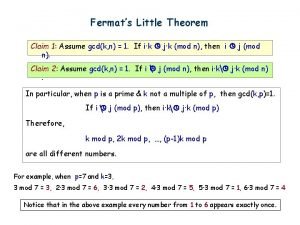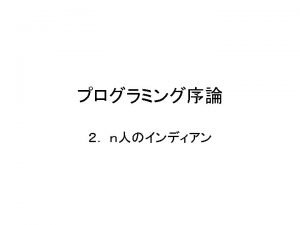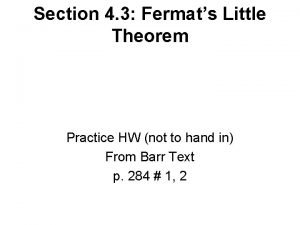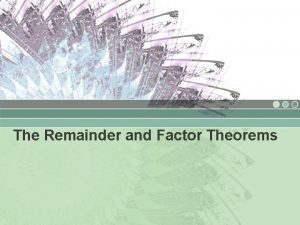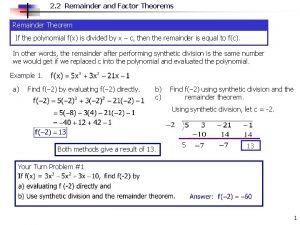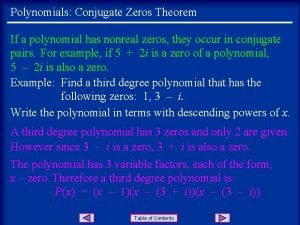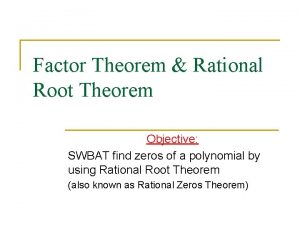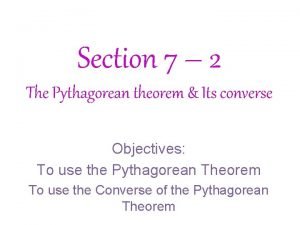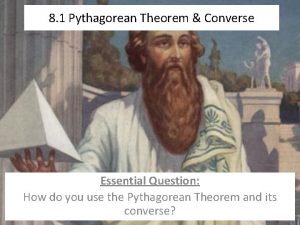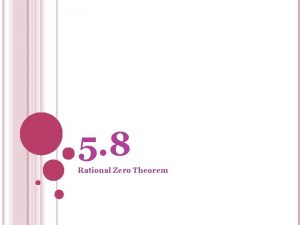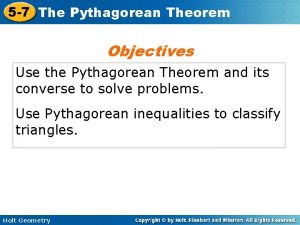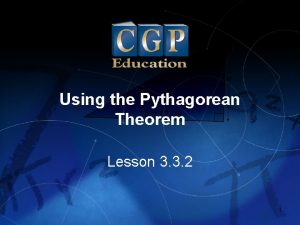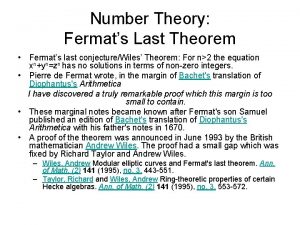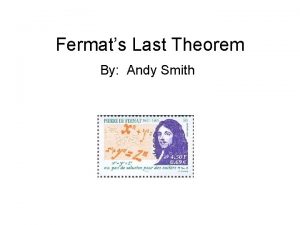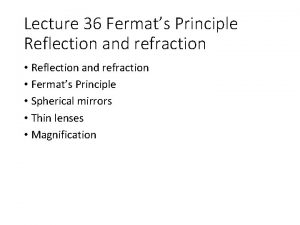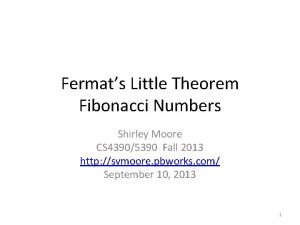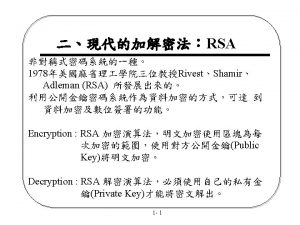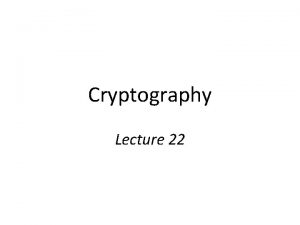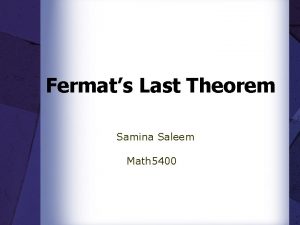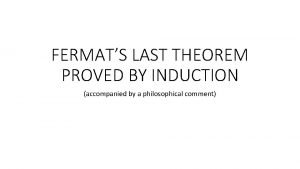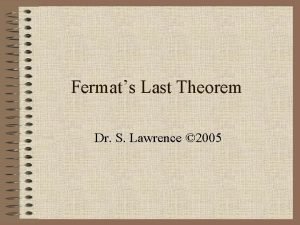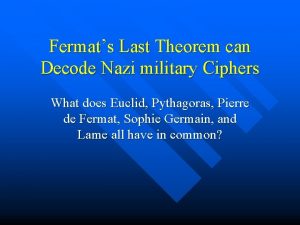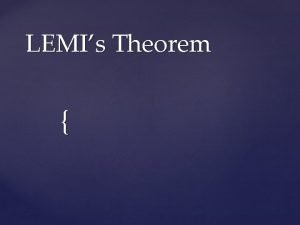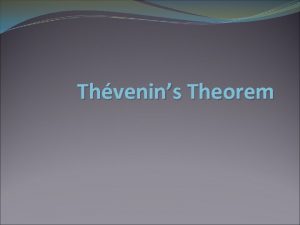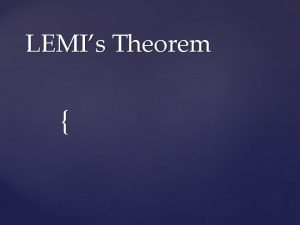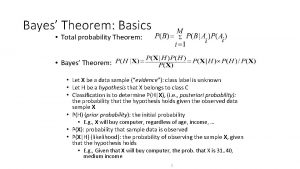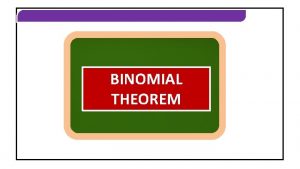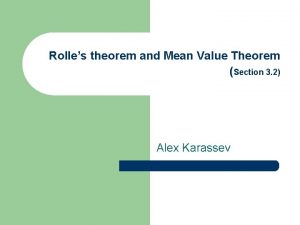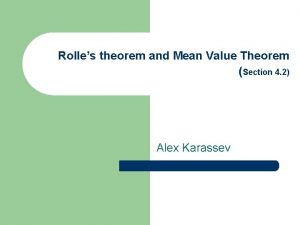Section 4 3 Fermats Little Theorem Practice HW

























- Slides: 25

Section 4. 3: Fermat’s Little Theorem Practice HW (not to hand in) From Barr Text p. 284 # 1, 2

• As we will see later, the RSA Cryptosystem will require exponentiation to encrypt and decrypt messages. In this section, we review the basics of exponentiation and demonstrate an efficient method for doing exponentiation in modular arithmetic.

Exponential Notation • Recall that exponential notation represents an expression of the form , where a represents the base of the expression and k represents the exponent. If the exponent k is a positive integer, then

Example 1: Compute Solution: and .

In this section, we want to consider the problem of computing The next example illustrates a basic computation with his quantity.

Example 2: Compute Solution: .

The last example illustrates that it is easy to do modular exponentiation when the exponent k is small. However, if the exponent becomes larger, this presents more of a challenge. If we are asked to compute , for example, we should note that , which due to size causes errors in computations due to computer round off. Our goal next is to present a method that overcomes this problem.

• Note: All laws of exponents in the real number system carry over to MOD arithmetic, except for division.

Laws of Exponents Real Number System Modular Number System

Method of Successive Squaring for • Idea is to break the exponent k into a sum of powers of 2 (starting with ) and break in terms of exponential terms as these powers of 2, computing the powers of 2 by “successively squaring” the previous term.

Example 3: Compute Solution:



Example 4: Compute Solution: We first note that the exponent k = 85. We first determine the powers of 2 that are less than this exponent. Starting with, we see that , , , We can stop at since

We now decompose the exponent k into powers of 2. We next write We next compute the needed powers of 7 needed with respect to the modulus 41. The ones that we will need are indicated by. Note that arrows are used to indicate the substitutions from the previous step.


Hence,

Note • In Example 4, to compute by ordinary exponentiation, 84 multiplications are required. Using successive squares requires only 9 multiplications.

Fermat’s Little Theorem in special cases can be used to simplify the process of modular exponentiation. We state it now. Fermat’s Little Theorem: Let p be a prime number, a an integer where. Then 1. If , then. 2. .

Example 5: Use Fermat’s Little Theorem to calculate the remainder when x is divided by the given divisor m, that is, calculate x MOD m. a. Solution: , m = 31.

b. Solution: , m = 941.

c. Solution: , m = 941.

Fermat’s Little Theorem can be used to simplify integers with large exponents if the modulus is prime. The next example illustrates how this works.

Example 6: Solve the equation Solution: .

 Fermat's little theorem example
Fermat's little theorem example 1 little 2 little 3 little indians
1 little 2 little 3 little indians 1 little 2 little 3 little indian
1 little 2 little 3 little indian Green's theorem is a relation between
Green's theorem is a relation between Fermat's little theorem modular exponentiation
Fermat's little theorem modular exponentiation Little hands little feet
Little hands little feet Little space meaning
Little space meaning Little grains of sand
Little grains of sand A few vai few
A few vai few Mouse mouse where is your house
Mouse mouse where is your house She is lucky she has few problems
She is lucky she has few problems Few a few little a little exercise
Few a few little a little exercise Complete the sentences. use enough with one of these words
Complete the sentences. use enough with one of these words Factor theoram
Factor theoram Remainder therom
Remainder therom Remainder theorem
Remainder theorem Conjugate zeros theorem
Conjugate zeros theorem Rational zero theorum
Rational zero theorum Linear factors theorem and conjugate zeros theorem
Linear factors theorem and conjugate zeros theorem Practice 11-2 the pythagorean theorem answer key
Practice 11-2 the pythagorean theorem answer key Converse of the pythagorean theorem
Converse of the pythagorean theorem Practice 8-1 the pythagorean theorem and its converse
Practice 8-1 the pythagorean theorem and its converse Is 5/8 rational
Is 5/8 rational 5-7 the pythagorean theorem answer key
5-7 the pythagorean theorem answer key 5-7 the pythagorean theorem
5-7 the pythagorean theorem Practice 11-2 the pythagorean theorem answer key
Practice 11-2 the pythagorean theorem answer key
